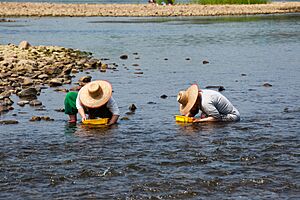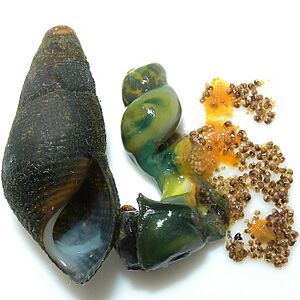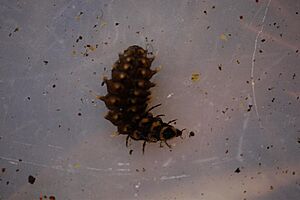Semisulcospira libertina facts for kids
Quick facts for kids Semisulcospira libertina |
|
|---|---|
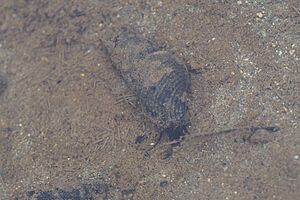 |
|
| S. libertina partially covered by detritus, but showing its basal cords, an important identifying feature | |
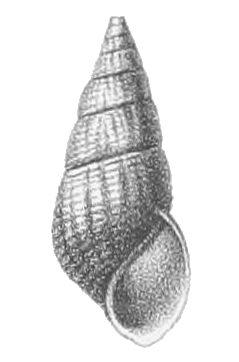 |
|
| Drawing of an apertural view of an S. libertina shell | |
| Conservation status | |
| Scientific classification | |
| Genus: |
Semisulcospira
|
| Species: |
libertina
|
 |
|
| Distribution map of Semisulcospira libertina | |
| Synonyms | |
|
Melania libertina Gould, 1859 |
|
The Semisulcospira libertina is a type of freshwater snail. It has a special lid called an operculum that closes its shell. This snail is an aquatic gastropod, which means it's a water-living mollusk in the family Semisulcospiridae.
You can find Semisulcospira libertina across East Asia. It lives in countries like China, Taiwan, Korea, Japan, and the Philippines. In some places, people collect these snails to eat. They are also important because they can carry tiny parasites that cause diseases in humans.
Contents
About This Snail
This snail was first described in 1859 by an American scientist named Augustus Addison Gould. He called it Melania libertina. The name libertina comes from Latin and means "freedwoman."
Scientists sometimes group very similar species together. S. libertina is part of a "species complex" with two other snails: S. reiniana and S. kurodai. This means they are closely related.
Where It Lives
This snail is found in many parts of Asia:
- South Korea: including the mainland and Jeju Island.
- China: in central, east, and south regions like Hubei, Anhui, Fujian, Jiangxi, Zhejiang, and Guangdong.
- Taiwan.
- Japan: It is the most common freshwater snail there.
- Philippines.
The first snails studied came from Shimoda City and Amami Ōshima in Japan. Scientists have also found old shells of Semisulcospira libertina in Japan that are about 27,000 years old.
What It Looks Like
The shell of Semisulcospira libertina usually has 4 to 6 spirals. The very tip, or apex, is often worn away. The shell is long and pointed. It has a simple opening and no hole at the bottom.
The shell can look very different from one snail to another. It usually has 7 to 12 spiral lines near the bottom. Sometimes, it also has ridges going across the shell. The shell is usually light yellow, but can sometimes be light brown. The pointed part is often darker. Many shells have purple-brown spiral bands, either one, two, or three bands.
In Japan, the shell is usually about 11 to 13 millimeters wide. It is about 26 to 28.6 millimeters tall. In Korea, the shells can be a bit wider (up to 19.37 mm) and taller (up to 22.57 mm).
The shell is mostly made of calcium. The snail's body also contains special colored substances called carotenoids.
Ecology
Habitat
Semisulcospira libertina lives in many different freshwater places. These include calm pools, slow-moving rivers, drainage ditches, and even rice paddies. They prefer water temperatures between 1.3 and 22.5 degrees Celsius.
These snails can live in water that is somewhat polluted.
Feeding Habits
Semisulcospira libertina eats many different things. It mainly grazes on tiny water plants called phytoplankton and dead plant material called detritus. They might also eat special bacteria that make their own food.
Life Cycle
Each Semisulcospira libertina snail is either male or female. The females carry their eggs inside their bodies until they hatch. This is called being ovoviviparous. The baby snails develop fully inside the mother's body.
A female snail can have over 80 tiny embryos in her special pouch. In some months, she might have 222 to 570 embryos. A single female can give birth to about 607 to 858 baby snails in one year. The most ever recorded was 1535 newborns from one snail in a year!
Snails are usually born when the water temperature is between 12 and 24 degrees Celsius. Most births happen in March-May and September-October. Newborn snails are very small, less than 2 millimeters tall. They usually live for about 2 years.
Parasites
Semisulcospira libertina can carry different types of tiny parasites called flukes. Some of these flukes can cause health problems in humans. For example, this snail can be the first host for parasites like Clonorchis sinensis, Paragonimus westermani, and Metagonimus miyatai. These parasites then move on to other animals before they can infect humans.
Predators
One known predator of Semisulcospira libertina is the aquatic larva of the Japanese firefly, Luciola cruciata.
Human Use
Culinary
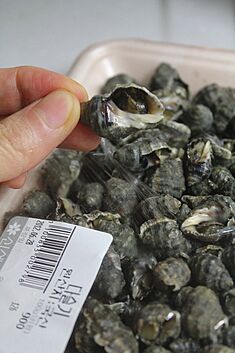
Pre-packaged Semisulcospira libertina snails sold in Korea
|
|
| Nutritional value per 100 g (3.5 oz) | |
|---|---|
| Saturated | 28.7% of fat |
| Monounsaturated | 35.5% of fat |
| Polyunsaturated | 35.8% of fat |
|
Protein
|
% of amino acids / % of free amino acids
|
| Tryptophan | / 0.22% |
| Threonine | 5.4% / 1.87% |
| Isoleucine | 4.6% / 0.06% |
| Leucine | 8.6% / 6.96% |
| Lysine | 6.9% / 2.87% |
| Methionine | 2.1% / 0.25% |
| Cystine | 1.2% / 1.92% |
| Phenylalanine | 4.4% / 0.0% |
| Tyrosine | 3.0% / 0.96% |
| Valine | 5.4% / 0.68 % |
| Arginine | 7.0% / 0.82% |
| Histidine | 2.4% / 0.35% |
| Alanine | 6.9% / 9.39% |
| Aspartic acid | 11.1% / 0.0% |
| Glutamic acid | 14.9% / 0.06% |
| Glycine | 6.6% / 2.77% |
| Proline | 5.1% / 0.52% |
| Serine | 4.4% / 0.09% |
| Vitamins | Quantity
%DV†
|
| Vitamin A equiv.
beta-Carotene
lutein zeaxanthin
|
280%
2240 μg
13%
1440 μg800 μg
|
| Minerals | Quantity
%DV†
|
| Calcium |
19%
194.5 mg |
| Iron |
8%
1.1 mg |
| Phosphorus |
2%
16.4 mg |
| Other constituents | Quantity |
| Water | 81.0 g |
| Crude fat | 1.2 g |
| Crude protein | 11.9 g |
| Crude ash | 1.9 g |
| Chlorophyll | 170 mg |
|
For 100 g of meat there would be need ~250–1000 snails.
|
|
| †Percentages estimated using US recommendations for adults. | |
In Japan
This snail is used in Japanese cuisine. People cook and eat it in various dishes.
In Korea
In Korean cuisine, these snails are called daseulgi. They are used to make a type of soup called daseulgi-guk (다슬기국). They are also used in pancakes and broths.
Medicinal Use
In Korea
In traditional Korean medicine, Semisulcospira libertina is used to help with stomach and liver problems. People use the whole snail to make juices, powders, or soups. For example, some use it for indigestion or other stomach issues. It's also used for liver-related sicknesses.
However, it's important to be careful. Inhaling powder from these snail shells can cause lung problems.







